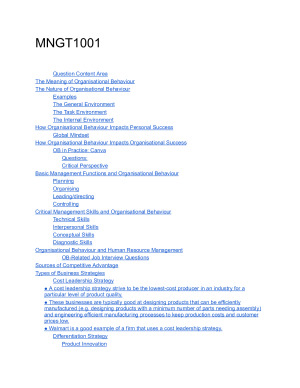MNGT1001 Course Notes
Subject notes for Newcastle MNGT1001
Description
Textbook based on organisational behaviour 10th edition Table of contents Question Content Area The Meaning of Organisational Behaviour The Nature of Organisational Behaviour Examples The General Environment The Task Environment The Internal Environment How Organisational Behaviour Impacts Personal Success Global Mindset How Organisational Behaviour Impacts Organisational Success OB in Practice: Canva Questions: Critical Perspective Basic Management Functions and Organisational Behaviour Planning Organising Leading/directing Controlling Critical Management Skills and Organisational Behaviour Technical Skills Interpersonal Skills Conceptual Skills Diagnostic Skills Organisational Behaviour and Human Resource Management OB-Related Job Interview Questions Sources of Competitive Advantage Types of Business Strategies Cost Leadership Strategy ● A cost leadership strategy strive to be the lowest-cost producer in an industry for a particular level of product quality. ● These businesses are typically good at designing products that can be efficiently manufactured ( designing products with a minimum number of parts needing assembly) and engineering efficient manufacturing processes to keep production costs and customer prices low. ● Walmart is a good example of a firm that uses a cost leadership strategy. Differentiation Strategy Product Innovation Specialisation Strategy Customer Intimacy Growth Strategy Where does Organisational Behaviour Come From? Scientific Management The Hawthorne Effect Organisations as Open Systems The Systems Approach to Organisations Situational Perspectives on Organisational Behaviour Universal versus Situational Approach Interactionism: People and Situations Enhancing Employee Commitment and Engagement Promoting Organisational Citizenship Behaviours Minimising Dysfunctional Behaviours Individual Differences The Concept of Fit Dimensions of Fit Person-Job Fit Person-Group Fit Person-Organisation Fit Person-Vocation Fit A Realistic View of the Job and Organisation ‘Big Five’ Personality Traits Agreeableness Conscientiousness Neuroticism Extroversion Openness The Value of the Big Five Framework The Myers-Briggs Framework The Value of the Myers-Briggs Framework Locus of Control Effects of Locus of Control on Organisational Outcomes Self-Efficacy Self-Esteem Authoritarianism Machiavellianism Tolerance for Risk and Ambiguity Type A and B Traits General Mental Ability Multiple Intelligences Matching Intelligence Types with Career Choices Emotional Intelligence Sensory Modalities Learning Style Inventory Attitudes in Organisations How Attitudes are Formed The Importance of Motivation The Motivational Framework Early Perspectives on Motivation Types of Compensation The Traditional Approach The Human Relations Approach The Human Resource Approach Individual Differences and Motivation What Motivates People? The ERG Theory The Two-Factor Theory The Two-Factor Theory of Motivation Types of Workgroups Command Groups Task Groups Affinity Groups Types of Teams Types of Teams Cross-Functional Teams Problem-Solving Teams Self-Managed Teams Virtual Teams Global Teams Increasing the Effectiveness of Global Teams Four strategies for dealing with the challenges of global teams are: 1. Adaptation: seeing a problem as a cultural difference and not a personality issue. This works when team members are willing and able to identify and acknowledge their cultural differences and to assume responsibility for figuring out how to live with them. 2. Structural intervention: changing the shape of the team. Social interaction and working can be structured to engage everyone on the team. 3. Managerial intervention: setting norms early or bringing in a higher-level manager. This usually works best early in a team’s life. 4. Exit: removing a team member when other options have failed. If emotions get too high and too much face has been lost, it can be almost impossible to get a team to work together effectively again. Informal Groups Group Composition Group Size Group Norms The Purposes of Norms Group Cohesiveness Group Cohesiveness, Goals and Productivity Problems Associated with Group Cohesiveness Informal Leadership Forming Storming Norming Performing Adjourning Understanding Team Performance Factors Process Gain and Process Loss Team Efficacy and Trust Social Facilitation and Roles Team Goals, Feedback and Rewards The Implementation Process Phase 1: Start-up Phase 2: Reality and Unrest Phase 3: Leader-Centred Teams Phase 4: Tightly Formed Teams ● Phase 5: Self-Managed Teams Leader Behaviours Understanding Benefits and Costs of Teams Benefits of Teams in Organisations Introduction Nature of Conflict Common Causes of Conflict Sources of Conflict Interpersonal Differences Interest Conflicts Change Differing Values Poor Communication Task Interdependence Organisational Structure Conflict Escalation Glasl’s Nine-Stage Model of Conflict Escalation De-Escalating Conflict Role of Emotion in Conflict Collaborating Compromising Competing Accommodating Avoiding Conflict Management Skills Creating Constructive Conflict Negotiating Skills
Newcastle
Semester 1, 2023
102 pages
17,663 words
$59.00
Campus
Newcastle, Newcastle City
Member since
March 2025
